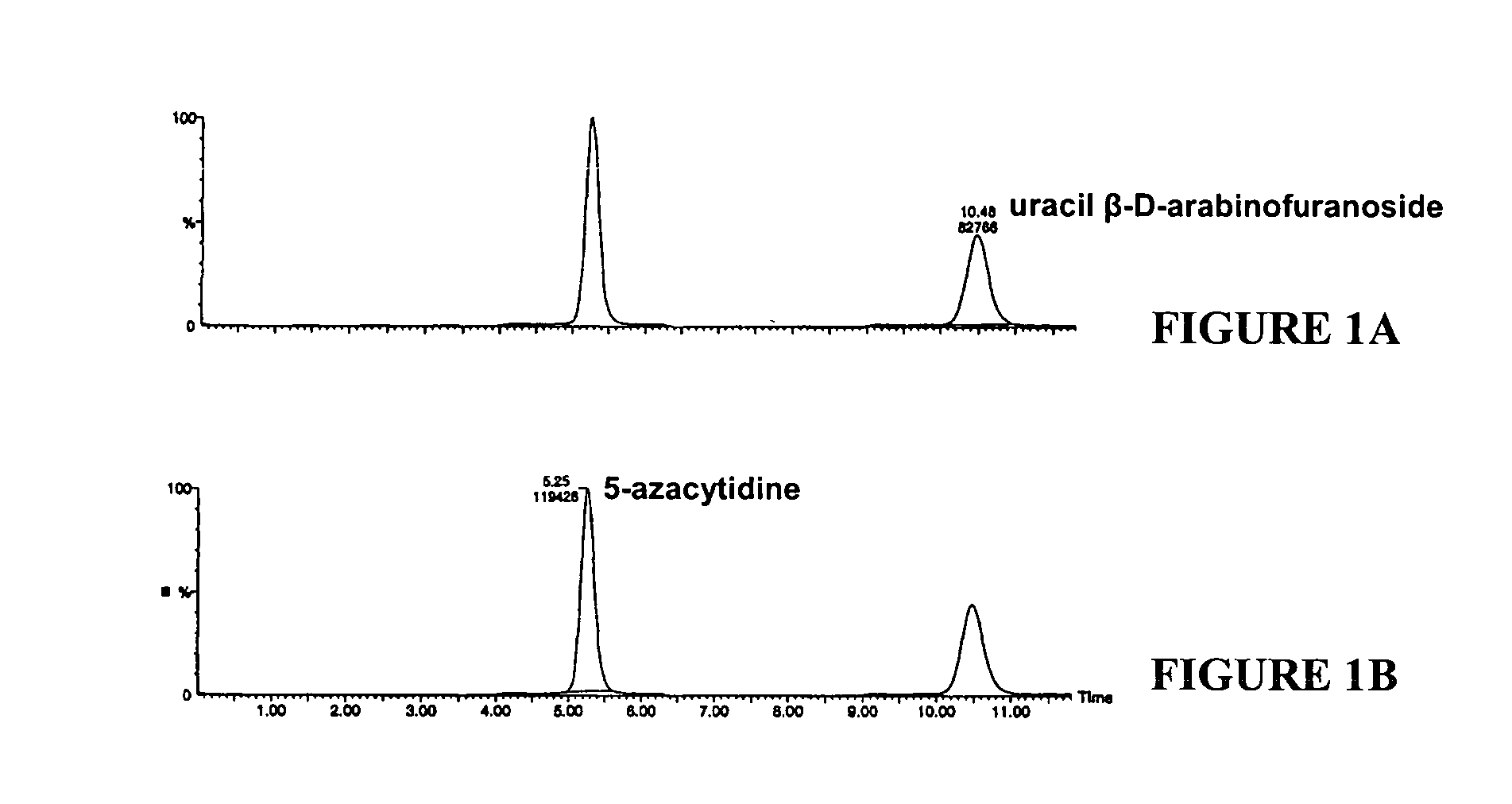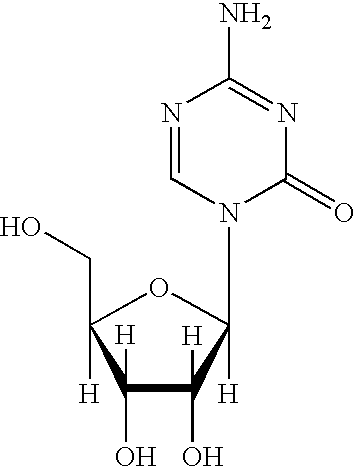Methods for stabilizing 5-azacytidine in plasma
- Summary
- Abstract
- Description
- Claims
- Application Information
AI Technical Summary
Problems solved by technology
Method used
Image
Examples
example 1
Stability of 5-Azacytidine in Whole Blood
[0019]5-Azacytidine was added to whole blood at a concentration of either 30 ng / ml or 400 ng / ml. The samples were incubated at room temperature or on ice for 15 minutes, 30 minutes, 45 minutes, or 60 minutes prior to quantitation; an additional sample was quantitated immediately following 5-azacytidine addition (Time 0).
[0020]Quantitation was performed as follows. Whole blood (3.0 mL) was centrifuged to obtain plasma, and a 100 μL aliquot of the plasma was then added to a polypropylene tube containing at least 200 mg of zinc sulfate and 2.0 mL of acetonitrile by dispensing below the surface of the acetonitrile. Then, to each acetonitrile / plasma mixture, 25 μL of 500 ng / mL uracil β-D-arabinofuranoside was added as an internal standard (IS). The mixture was vortexed for 5 minutes, and then centrifuged for at least 5 minutes at 3000 rpm at 5° C. The acetonitrile layer was then transferred to a new polypropylene tube by pipetting. The acetonitril...
example 2
Stability of 5-Azacytidine Stored in Acetonitrile / Plasma Mixtures at Different Temperatures
[0024]5-azacytidine was added to whole blood at a concentration of either 30 ng / ml or 400 ng / ml. The whole blood (3.0 mL) was centrifuged to obtain plasma, and a 100 μL aliquot of the plasma was then added to a polypropylene tube containing at least 200 mg zinc sulfate and 2.0 mL acetonitrile by dispensing the plasma below the surface of the acetonitrile. The tube was vortexed for 5 minutes, and then centrifuged at approximately 3,000 rpm in a Beckman centrifuge for 5 minutes at 5° C. The acetonitrile / plasma mixtures were stored either for one freeze-thaw cycle (minus 70° C. for 4 days followed by room temperature (RT) for 5.5 hours) or at room temperature (RT) for approximately 3 hours. Additional samples were subjected to immediate 5-azacytidine determination without storage.
[0025]All 5-azacytidine determinations were performed as follows. To each acetonitrile / plasma mixture, 25 μL of a 500 ...
example 3
Stability of 5-Azacytidine Stored as an Acetonitrile Residue at Minus 70° C.
[0029]5-Azacytidine was added to plasma at a concentration of either 30 ng / ml or 400 ng / ml. A 100 μL aliquot of the plasma was then added to a polypropylene tube containing at least 200 mg zinc sulfate and 2.0 mL acetonitrile by dispensing the plasma below the surface of the acetonitrile. To each acetonitrile / plasma mixture, 25 μL of a 500 ng / mL uracil β-D-arabinofuranoside solution was added as an internal standard (IS). The tube was vortexed for 5 minutes, and then centrifuged for 5 minutes at approximately 3000 rpm in a Beckman centrifuge at 5° C. The acetonitrile layer was then transferred to a new polypropylene tube by pipetting. The acetonitrile layer was then evaporated using a turbo evaporator set at 45° C. to yield an acetonitrile residue.
[0030]The acetonitrile residue was then stored at minus 70° C. for the time periods specified in Table 3 below. At each time point, the 5-azacytidine in the aceton...
PUM
| Property | Measurement | Unit |
|---|---|---|
| pH | aaaaa | aaaaa |
| pH | aaaaa | aaaaa |
| temperature | aaaaa | aaaaa |
Abstract
Description
Claims
Application Information
 Login to View More
Login to View More - R&D
- Intellectual Property
- Life Sciences
- Materials
- Tech Scout
- Unparalleled Data Quality
- Higher Quality Content
- 60% Fewer Hallucinations
Browse by: Latest US Patents, China's latest patents, Technical Efficacy Thesaurus, Application Domain, Technology Topic, Popular Technical Reports.
© 2025 PatSnap. All rights reserved.Legal|Privacy policy|Modern Slavery Act Transparency Statement|Sitemap|About US| Contact US: help@patsnap.com


